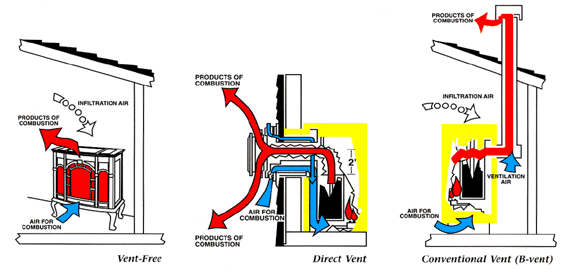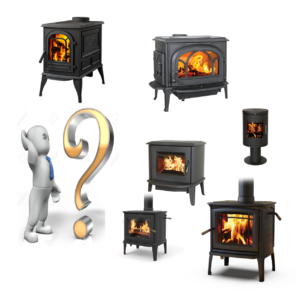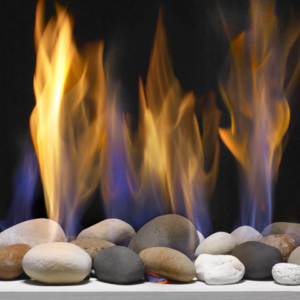Description
Direct vent appliances are not, contrary to popular belief, appliances that just “vent directly out the wall”. Direct vent means that the appliance takes its combustion air from outside rather than inside the room, and it does this via the venting system. However, one of the best things about that direct vent appliances is that they can indeed by vented directly though the wall. Through-the-wall installations are affordable because they do not require a lot of vent like through-the-roof installations require. In addition, they tend to be easier to install as they don’t require climbing onto a roof and flashing the vent cap in. Another great advantage to direct vent stoves and fireplaces is that since they draw their combustion air from outside, depleting the room of oxygen is not an issue. Subsequently, direct vent appliances can be installed in “confined spaces” where natural vent appliances that take their combustion air from inside the room cannot. There are two main types of direct vent: coaxial vent and co-linear vent. Coaxial means that there is a pipe inside of a pipe, and co-axial vent is most commonly used with gas stoves and fireplaces in through-the-wall or through-the-roof installations. Co-linear vent is used when installing a gas fireplace insert into existing fireplaces because they are flexible and can easily be dropped down the chimney and pass around smoke shelves. Sometimes co-linear direct vent is used in combination with co-axial direct vent when installing a gas stove into an existing chimney, though this tends to be a bit more expensive. Fortunately, we have B-Vent gas stoves that can easily and affordably be installed into chimneys using affordable, single wall aluminum B-vent liners.
B-Vent appliances are natural draft appliances that draw their combustion air from within the living space. If you have an existing chimney and your appliance is not being installed into a confined space or in any other manner not in compliance with manufacturer specifications, B-vent gas appliances are a great alternative to direct vent appliances as the venting typically costs one fourth to one half as much as direct vent, and in many cases, B-vent stoves are more efficient and offer more heat output. Many customers who have burned wood stoves all their lives but want to transition to the ease of a gas stove choose B-Vent gas stoves, such as the Jotul GF 300 BV Allagash or the Jotul GF 400 BV Sebago. These stoves look just like their direct vent counterparts, but can be installed using aluminum B-vent instead of direct vent pipe, and in the case of the Sebago, they are more efficient and offer more heat output than their direct vent counterparts.
Vent Free appliances simply vent straight into the room and must be specifically designed for that purpose. You can never simply vent a direct vent or b-vent appliance into the room. Vent free appliances are among the most difficult to install from the perspective of building codes, so do your homework to make sure they can be installed in the space you want. In addition, since a byproduct of gas combustion is water vapor, vent free appliance emit a considerable amount of water vapor into the home, which can be problematic. Caution must be taken to ensure that your vent free appliance is properly maintained to ensure that it is burning correctly as carbon monoxide is a byproduct of incomplete combustion. At Mazzeo’s, we generally do not sell vent-free gas products, and most of the gas product lines that we sell do not make vent free products anymore.





